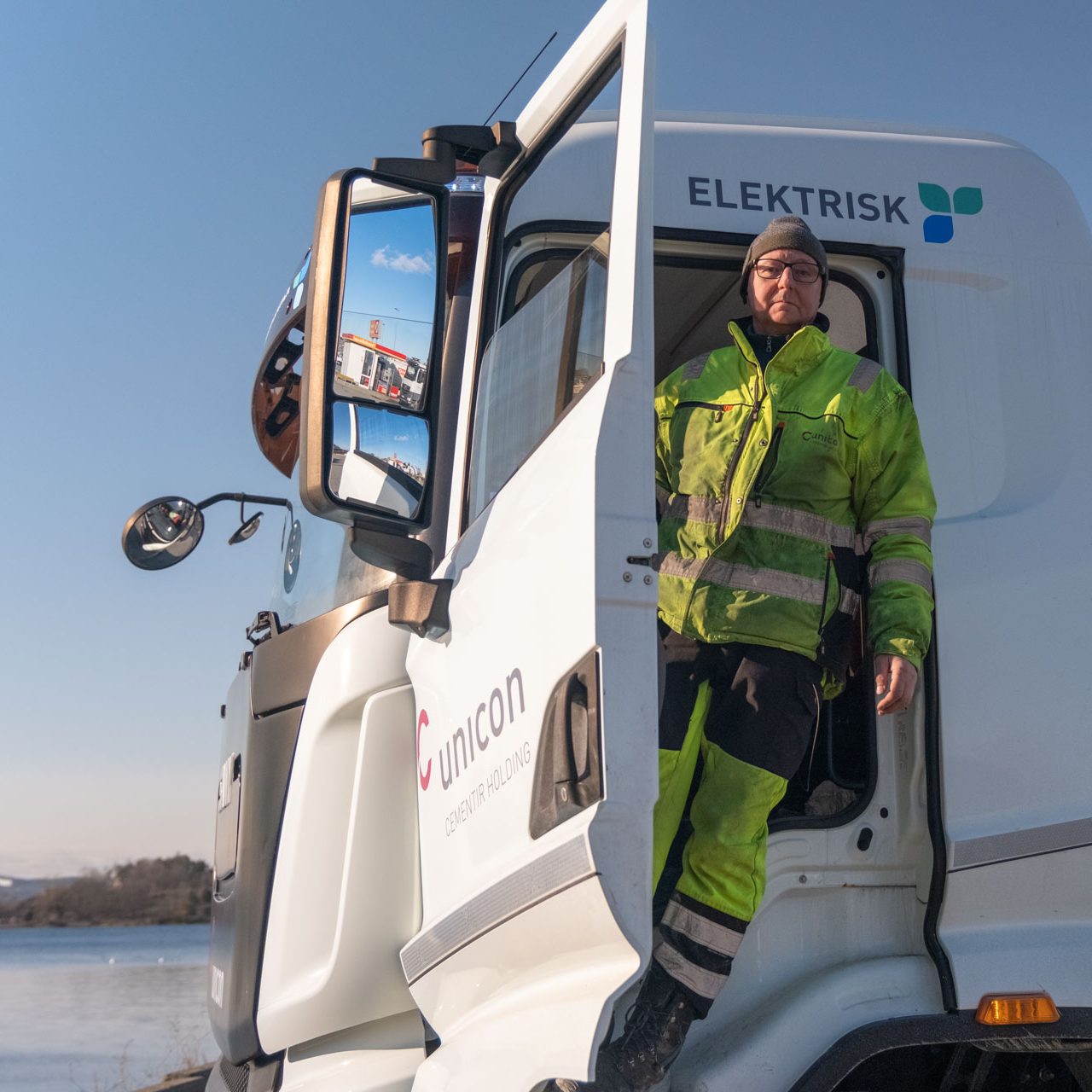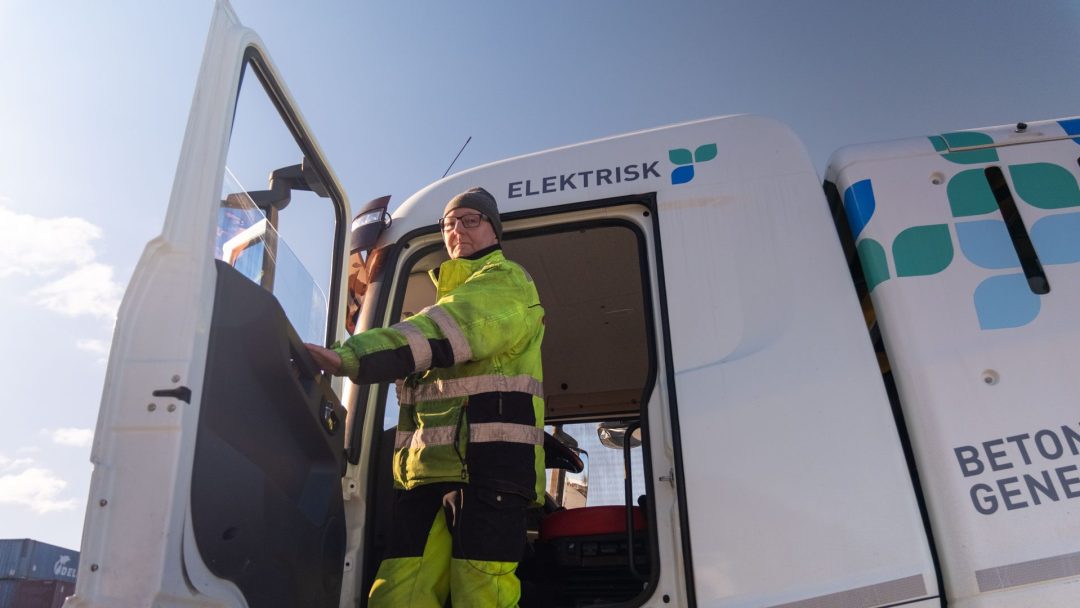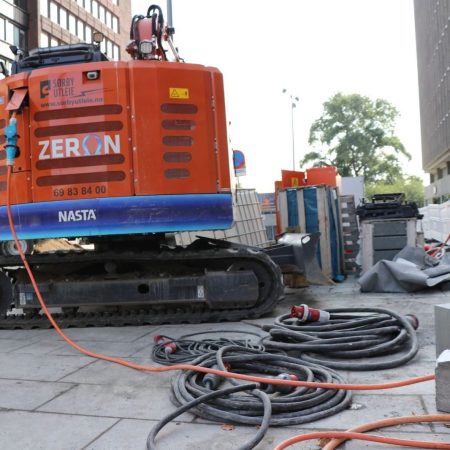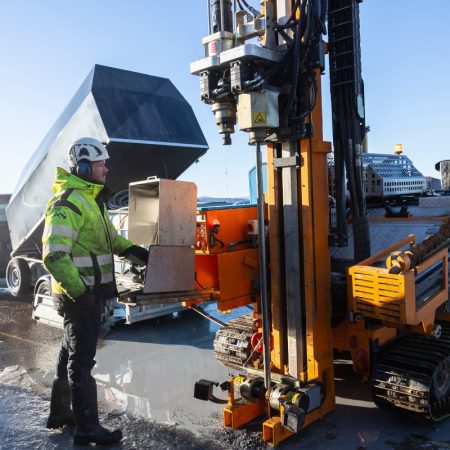Size: large
Type: image


Wojciech Nadaj is the driver of the electric concrete trucks at Unicon.
The low hum can be heard as the concrete drum slowly rotates. That’s how quiet it can be when an electric concrete truck mixes concrete. Heavy electric vehicles have long since entered the market. Already, there are several types of heavy electric vehicles, such as tractor units, tipper trucks, and box trucks.
Now, electric concrete trucks are also available.
Concrete is mixed in the electric concrete truck.
– Oslo aims to be a leading city in emission-free heavy transport. That’s why we in the municipality are working with instruments to ensure that the city’s businesses are early adopters of this transition. It’s exciting to see that it’s working, with more and more emission-free trucks on Oslo’s roads,” says Margrethe Lunder, climate advisor at the Climate Agency in Oslo Municipality

Margrethe Lunder, climate advisor at the Climate Agency in Oslo Municipality.
- The charging station at Grønlikaia was established in 2023 as part of the municipality’s initiative to expand charging stations for heavy vehicles.
- The charging station has six fast-charging spots for heavy vehicles in Oslo.
- During 2024, more fast-charging stations for heavy transport will be installed in Oslo as a result of the support scheme from the City of Oslo.
Among the First in Norway
Concrete supplier Unicon is one of the first in Norway to purchase electric concrete trucks. They have utilized Enova’s support scheme and now have three Sany 408P and five Volvo FH Electric, totaling eight electric vehicles. So far, they are satisfied with the electric concrete trucks. They brought both concrete truck models to Grønlikaia today.
– After using the vehicles through a relatively harsh winter, we are satisfied with both functionality and operational capability. However, we must consider the need for charging during the workday, says Kjetil Hundekilen, logistics director at Unicon. He further explains that the range varies depending on weather conditions, road conditions, and the chosen route, as well as the time spent unloading.

Kjetil Hundekilen, logistics director at Unicon.
– Our experience so far this winter has shown a range of about 150-200 kilometers. We are curious to see what the numbers will be when the weather becomes milder, says Kjetil Hundekilen
About Unicon
Concrete supplier with 150 employees and 24 permanent plants from Steinkjer in the north to Mandal in the south.
Comfortable to Drive and Safer Workdays
Driver Wojciech Nadaj stands next to the Sany concrete truck.
– This truck can carry four loads of concrete from Sjursøya to Huseby before needing to charge, he says, pointing to the battery and the drum. The Volvo can carry three.
The drum speed is controlled from the cab. Wojciech walks over to the Volvo concrete truck and jumps into the cab to demonstrate. He is pleased with the cab’s ergonomics. The seat is comfortable, and the steering wheel can be adjusted to various heights and angles.
The drum speed is controlled from the cab, which has seven speed levels.
Logistics director Kjetil Hundekilen says the general feedback from drivers is that the electric trucks are comfortable to drive.
– Both noise and vibration levels are almost zero. This means they feel less fatigued, leading to safer workdays for both drivers and others on the road. Drivers also need to think differently. In addition to planning their mandatory breaks, they now also need to plan for charging, says Hundekilen. He adds that Unicon is continuously working to reduce its environmental footprint and improve its health and safety practices. Investing in electric concrete trucks is an important part of this effort.
Less Noise with Electric
A fossil-fuel concrete truck suddenly rumbles into Grønlikaia to refuel with diesel. The roar drowns out the quiet drum of the electric concrete truck. At that moment, we especially notice how quiet the electric concrete truck is.
What are the biggest differences from fossil-fuel concrete trucks?
– The major difference is in range and charging time. To achieve full utilization, routes must now be planned more carefully, and driving must be more economical than before. Unlike a fossil-fuel truck, which can run for several days without refueling, an electric concrete truck has fewer effective operating hours per workday.
Kjetil Hundekilen explains that this leads to fewer hours worked. He believes that economic compensation from the authorities could make the transition easier for more companies.
Now, the electric concrete truck has charged its batteries and is ready for the rest of the workday.
More Demands and More Chargers Needed
Kjetil Hundekilen explains that Unicon chose to be early adopters of a relatively large fleet of electric concrete trucks because of the requirements set by Oslo Municipality for emission-free construction sites on their projects.
What will determine our further investment in zero-emission vehicles will be our customers’ willingness to pay. So far, we have seen that it is the public sector that demands this and is also willing to pay the extra cost.
What measures do you believe are important for more people to invest in zero-emission trucks in Oslo?
– For us, who operate with small economic margins, it is crucial that the investment in zero-emission trucks is economically sustainable. Measures from the municipality that help ensure this will have the greatest effect, says Kjetil Hundekilen, emphasizing the importance of incentives to accelerate the process.
– At the same time, it is crucial to facilitate more efficient operation of electric trucks by ensuring sufficient charging opportunities. We need more fast chargers suitable for trucks, as current charging options are limited. We often experience queues at charging stations, which unnecessarily reduces the practical operating time and earning potential for electric trucks.
Batteries Charged
The two electric concrete trucks have both charged their batteries and are now ready for the rest of the workday. Driver Wojciech Nadaj waves as he drives out of the charging station at Grønlikaia and heads towards Huseby for an electric concrete delivery.
- Analyze your usage needs – what do you need in terms of vehicle use?
- Consider battery vs. load. In Oslo, for example, you don’t need more than four batteries.
- Remember that this is still new; it’s better to have some electric vehicles in your fleet than none.



